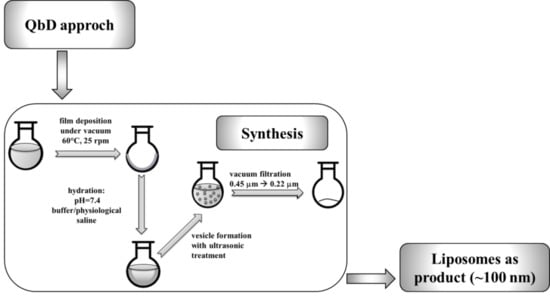Pharmaceutical Development and Design of Thermosensitive Liposomes Based on the QbD Approach
Abstract
:1. Introduction
2. Materials and Methods
2.1. Materials
2.2. Methods
2.2.1. Elements of the QbD Design
Development of the Knowledge Space and Determination of the QTPP, CQAs, CMAs, and CPPs
2.2.2. Risk Assessment
2.3. Design of Experiments (DoE)
2.4. Preparation of Thermosensitive Liposomes
2.5. Characterisation of the Liposomes
2.5.1. Vesicle Size and Zeta Potential of the Liposomes
2.5.2. Differential Scanning Calorimetry (DSC) and Thermogravimetric Analysis (TGA) Investigations
2.5.3. Transmission Electron Microscopy (TEM) Measurements
2.5.4. Fourier-Transform Infrared (FT-IR) Spectroscopy Measurements
2.5.5. Atomic Force Microscopy (AFM)
2.6. Statistical Analysis
3. Results and Discussion
3.1. Initial Knowledge Space Development
3.2. Risk Assessment
3.3. Design of Experiments (DoE)
3.4. Results of the Vesicle Size and the Zeta Potential Analysis
3.4.1. Results of the Differential Scanning Calorimetry (DSC) and the Thermogravimetric Analysis (TGA) Investigations
3.4.2. Results of the Fourier-Transform Infrared (FT-IR) Spectroscopy Measurements
3.4.3. Results of the Transmission Electron Microscopy (TEM) and the Atomic Force Microscopy (AFM) Spectroscopy Measurements
4. Conclusions
Author Contributions
Funding
Institutional Review Board Statement
Informed Consent Statement
Conflicts of Interest
Sample Availability
Abbreviations
| CMAs | critical material attributes |
| CPPs | critical process parameters |
| CQAs | critical quality attributes |
| DLS | dynamic light scattering |
| DPPC | 1,2-dipalmitoyl-sn-glycero-3-phosphocholine |
| DSPC | 1,2-dioctadecanoyl-sn-glycero-3-phosphocholine |
| DSPE–PEG3000 | 1,2-distearoyl-sn-glycero-3-phosphoethanolamine-N-[methoxy(polyethylene glycol)-3000] |
| DSC | differential scanning calorimetry |
| EMA | European medicine agency |
| FT-IR | Fourier-transform infrared spectroscopy |
| ΔHm | enthalpy change |
| ICH | International Council for Harmonisation of Technical Requirements for Pharmaceuticals for Human Use |
| MAs | material attributes |
| TSL | thermosensitive liposomes |
| LTSL | low-temperature sensitive liposomes |
| HTSL | high-temperature sensitive liposomes |
| PBS | phosphate-buffered saline |
| PSS | 0.9% NaCl solution (physiological saline solution) |
| PdI | polydispersity index |
| QbD | quality by design |
| QTPP | quality target product profile |
| R&D | research and development |
| RA | risk assessment |
| TEM | transmission electron microscopy |
| TGA | thermogravimetric analysis |
| Tg | glass transition temperature |
| Tm | phase transition temperature |
References
- Maherani, B.; Arab-Tehrany, E.; R Mozafari, M.; Gaiani, C.; Linder, M. Liposomes: A Review of Manufacturing Techniques and Targeting Strategies. Curr. Nanosci. 2011, 7, 436–452. [Google Scholar] [CrossRef]
- Bangham, A.D.; Standish, M.M.; Watkins, J.C. Diffusion of univalent ions across the lamellae of swollen phospholipids. J. Mol. Biol. 1965, 13, 238–252. [Google Scholar] [CrossRef]
- Zhang, W.; Gong, C.; Chen, Z.; Li, M.; Li, Y.; Gao, J. Tumor microenvironment-activated cancer cell membrane-liposome hybrid nanoparticle-mediated synergistic metabolic therapy and chemotherapy for non-small cell lung cancer. J. Nanobiotechnol. 2021, 19, 339. [Google Scholar] [CrossRef] [PubMed]
- Liu, Y.; Huang, L. Preparation and Characterization of siRNA-Loaded Liposomes. In Methods in Molecular Biology (Clifton, N.J.); Springer: Berlin/Heidelberg, Germany, 2021; Volume 2282, pp. 159–169. ISBN 978-1-0716-1297-2. [Google Scholar]
- Cheng, L.; Zhang, X.; Tang, J.; Lv, Q.; Liu, J. Gene-engineered exosomes-thermosensitive liposomes hybrid nanovesicles by the blockade of CD47 signal for combined photothermal therapy and cancer immunotherapy. Biomaterials 2021, 275, 120964. [Google Scholar] [CrossRef] [PubMed]
- Cevenini, A.; Celia, C.; Orrù, S.; Sarnataro, D.; Raia, M.; Mollo, V.; Locatelli, M.; Imperlini, E.; Peluso, N.; Peltrini, R.; et al. Liposome-embedding silicon microparticle for oxaliplatin delivery in tumor chemotherapy. Pharmaceutics 2020, 12, 559. [Google Scholar] [CrossRef] [PubMed]
- Lo, Y.L.; Chang, C.H.; Wang, C.S.; Yang, M.H.; Lin, A.M.Y.; Hong, C.J.; Tseng, W.H. PEG-coated nanoparticles detachable in acidic microenvironments for the tumor-directed delivery of chemo- And gene therapies for head and neck cancer. Theranostics 2020, 10, 6695–6714. [Google Scholar] [CrossRef] [PubMed]
- Targhi, A.A.; Moammeri, A.; Jamshidifar, E.; Abbaspour, K.; Sadeghi, S.; Lamakani, L.; Akbarzadeh, I. Synergistic effect of curcumin-Cu and curcumin-Ag nanoparticle loaded niosome: Enhanced antibacterial and anti-biofilm activities. Bioorg. Chem. 2021, 115, 105116. [Google Scholar] [CrossRef]
- Xu, Y.; Yao, Y.; Wang, L.; Chen, H.; Tan, N. Hyaluronic acid coated liposomes Co-delivery of natural cyclic peptide RA-XII and mitochondrial targeted photosensitizer for highly selective precise combined treatment of colon cancer. Int. J. Nanomed. 2021, 16, 4929–4942. [Google Scholar] [CrossRef]
- Imperlini, E.; Celia, C.; Cevenini, A.; Mandola, A.; Raia, M.; Fresta, M.; Orrù, S.; Di Marzio, L.; Salvatore, F. Nano-bio interface between human plasma and niosomes with different formulations indicates protein corona patterns for nanoparticle cell targeting and uptake. Nanoscale 2021, 13, 5251–5269. [Google Scholar] [CrossRef]
- Zhang, Y.; Xie, F.; Yin, Y.; Zhang, Q.; Jin, H.; Wu, Y.; Pang, L.; Li, J.; Gao, J. Immunotherapy of tumor RNA-loaded lipid nanoparticles against hepatocellular carcinoma. Int. J. Nanomed. 2021, 16, 1553–1564. [Google Scholar] [CrossRef]
- Dua, J.S.; Rana, P.A.; Bhandari, D.K. Liposome: Methods Of Preparation And Applications. Int. J. Pharm. Stud. Res. 2012, 3, 14–20. [Google Scholar]
- Barenholz, Y. Doxil®—The first FDA-approved nano-drug: Lessons learned. J. Control. Release 2012, 160, 117–134. [Google Scholar] [CrossRef]
- Motamarry, A.; Asemani, D.; Haemmerich, D. Thermosensitive Liposomes. In Liposomes; Catala, A., Ed.; IntechOpen: Rijeka, Croatia, 2017. [Google Scholar]
- Haemmerich, D.; Motamarry, A. Chapter Five-Thermosensitive Liposomes for Image-Guided Drug Delivery. In Cancer Nanotechnology; Broome, A.-M., Ed.; Academic Press: Cambridge, MA, USA, 2018; Volume 139, pp. 121–146. ISBN 0065-230X. [Google Scholar]
- Chen, J.; He, C.; Lin, A.; Gu, W.; Chen, Z.; Li, W.; Cai, B. Thermosensitive liposomes with higher phase transition temperature for targeted drug delivery to tumor. Int. J. Pharm. 2014, 475, 408–415. [Google Scholar] [CrossRef]
- Kong, G.; Anyarambhatla, G.; Petros, W.P.; Braun, R.D.; Colvin, O.M.; Needham, D.; Dewhirst, M.W. Efficacy of liposomes and hyperthermia in a human tumor xenograft model: Importance of triggered drug release. Cancer Res. 2000, 60, 6950–6957. [Google Scholar] [PubMed]
- Park, K. Facing the Truth about Nanotechnology in Drug Delivery. ACS Nano 2013, 7, 7442–7447. [Google Scholar] [CrossRef] [PubMed] [Green Version]
- Weinstein, J.N.; Magin, R.L.; Yatvin, M.B.; Zaharko, D.S. Liposomes and local hyperthermia: Selective delivery of methotrexate to heated tumors. Science 1979, 204, 188–191. [Google Scholar] [CrossRef] [PubMed]
- Magin, R.L.; Hunter, J.M.; Niesman, M.R.; Bark, G.A. Effect of vesicle size on the clearance, distribution, and tumor uptake of temperature-sensitive liposomes. Cancer Drug Deliv. 1986, 3, 223–237. [Google Scholar] [CrossRef] [PubMed]
- Kono, K.; Zenitani, K.; Takagishi, T. Novel pH-sensitive liposomes: Liposomes bearing a poly(ethylene glycol) derivative with carboxyl groups. Biochim. Biophys. Acta 1994, 1193, 1–9. [Google Scholar] [CrossRef]
- Yu, L.X. Pharmaceutical quality by design: Product and process development, understanding, and control. Pharm. Res. 2008, 25, 781–791. [Google Scholar] [CrossRef] [PubMed]
- Yu, L.X.; Amidon, G.; Khan, M.A.; Hoag, S.W.; Polli, J.; Raju, G.K.; Woodcock, J. Understanding pharmaceutical quality by design. AAPS J. 2014, 16, 771–783. [Google Scholar] [CrossRef] [Green Version]
- Csóka, I.; Pallagi, E.; Paál, T.L. Extension of quality-by-design concept to the early development phase of pharmaceutical R&D processes. Drug Discov. Today 2018, 23, 1340–1343. [Google Scholar] [CrossRef]
- Porfire, A.; Achim, M.; Barbalata, C.; Rus, I.; Tomuta, I.; Cristea, C. Pharmaceutical Development of Liposomes Using the QbD Approach. Liposomes-Adv. Perspect. 2019, 2019, 1–20. [Google Scholar] [CrossRef] [Green Version]
- Xu, X.; Costa, A.P.; Khan, M.A.; Burgess, D.J. Application of quality by design to formulation and processing of protein liposomes. Int. J. Pharm. 2012, 434, 349–359. [Google Scholar] [CrossRef] [PubMed]
- Levacheva, I.; Samsonova, O.; Tazina, E.; Beck-Broichsitter, M.; Levachev, S.; Strehlow, B.; Baryshnikova, M.; Oborotova, N.; Baryshnikov, A.; Bakowsky, U. Optimized thermosensitive liposomes for selective doxorubicin delivery: Formulation development, quality analysis and bioactivity proof. Colloids Surf. B Biointerfaces 2014, 121, 248–256. [Google Scholar] [CrossRef] [PubMed]
- Bhattacharyya, S.; Adhikari, H.; Regmi, D. A brief review on qbd approach on liposome and the requirements for regulatory approval. Res. J. Pharm. Technol. 2019, 12, 4057–4065. [Google Scholar] [CrossRef]
- Xu, X.; Khan, M.A.; Burgess, D.J. A quality by design (QbD) case study on liposomes containing hydrophilic API: I. Formulation, processing design and risk assessment. Int. J. Pharm. 2011, 419, 52–59. [Google Scholar] [CrossRef] [PubMed]
- Li, J.; Qiao, Y.; Wu, Z. Nanosystem trends in drug delivery using quality-by-design concept. J. Control. Release 2017, 256, 9–18. [Google Scholar] [CrossRef]
- Németh, Z.; Pallagi, E.; Dobó, D.G.; Csóka, I. A proposed methodology for a risk assessment-based liposome development process. Pharmaceutics 2020, 12, 1164. [Google Scholar] [CrossRef]
- Reddi, B.A.J. Why is saline so acidic (and does it really matter?). Int. J. Med. Sci. 2013, 10, 747–750. [Google Scholar] [CrossRef] [Green Version]
- Pallagi, E.; Karimi, K.; Ambrus, R.; Szabó-Révész, P.; Csóka, I. New aspects of developing a dry powder inhalation formulation applying the quality-by-design approach. Int. J. Pharm. 2016, 511, 151–160. [Google Scholar] [CrossRef]
- Ishikawa, K.; Lu, D.J. What Is Total Quality Control? The Japanese Way; Prentice-Hall: Englewood Cliffs, NJ, USA, 1985; ISBN 0139524339 9780139524332 013952441X 9780139524417. [Google Scholar]
- ICH Expert Working Group. ICH Pharmaceutical Development Q8. ICH Harmon. Tripart. Guidel. 2009, 8, 1–28. [Google Scholar]
- Powell, T.; Sammut-Bonnic, T. Pareto Analysis. In Wiley Encyclopedia of Management; Cooper, C.L., Ed.; John Wiley & Sons, Ltd.: Hoboken, NJ, USA, 2014. [Google Scholar]
- Bozzuto, G.; Molinari, A. Liposomes as nanomedical devices. Int. J. Nanomed. 2015, 10, 975–999. [Google Scholar] [CrossRef] [Green Version]
- Tefas, L.R.; Sylvester, B.; Tomuta, I.; Sesarman, A.; Licarete, E.; Banciu, M.; Porfire, A. Development of antiproliferative long-circulating liposomes co-encapsulating doxorubicin and curcumin, through the use of a quality-by-design approach. Drug Des. Dev. Ther. 2017, 11, 1605–1621. [Google Scholar] [CrossRef] [PubMed] [Green Version]
- Demetzos, C. Differential Scanning Calorimetry (DSC): A tool to study the thermal behavior of lipid bilayers and liposomal stability. J. Liposome Res. 2008, 18, 159–173. [Google Scholar] [CrossRef] [PubMed]
- Ingvarsson, P.T.; Yang, M.; Nielsen, H.M.; Rantanen, J.; Foged, C. Stabilization of liposomes during drying. Expert Opin. Drug Deliv. 2011, 8, 375–388. [Google Scholar] [CrossRef]
- Yavlovich, A.; Singh, A.; Tarasov, S.; Capala, J.; Blumenthal, R.; Puri, A. Design of Liposomes Containing Photopolymerizable Phospholipids for Triggered Release of Contents. J. Therm. Anal. Calorim. 2009, 98, 97–104. [Google Scholar] [CrossRef] [Green Version]
- Li, L.; ten Hagen, T.L.M.; Schipper, D.; Wijnberg, T.M.; van Rhoon, G.C.; Eggermont, A.M.M.; Lindner, L.H.; Koning, G.A. Triggered content release from optimized stealth thermosensitive liposomes using mild hyperthermia. J. Control. Release 2010, 143, 274–279. [Google Scholar] [CrossRef]
- Mabrey, S.; Sturtevant, J.M. Investigation of phase transitions of lipids and lipid mixtures by high sensitivity differential scanning calorimetry. Proc. Natl. Acad. Sci. USA 1976, 73, 3862–3866. [Google Scholar] [CrossRef] [Green Version]
- Derenne, A.; Claessens, T.; Conus, C.; Goormaghtigh, E. Infrared Spectroscopy of Membrane Lipids. In Encyclopedia of Biophysics; Springer: Berlin/Heidelberg, Germany, 2013; pp. 1074–1081. ISBN 978-3-642-16711-9. [Google Scholar]
- Sharma, A.; Sharma, U.S. Liposomes in drug delivery: Progress and limitations. Int. J. Pharm. 1997, 154, 123–140. [Google Scholar] [CrossRef]


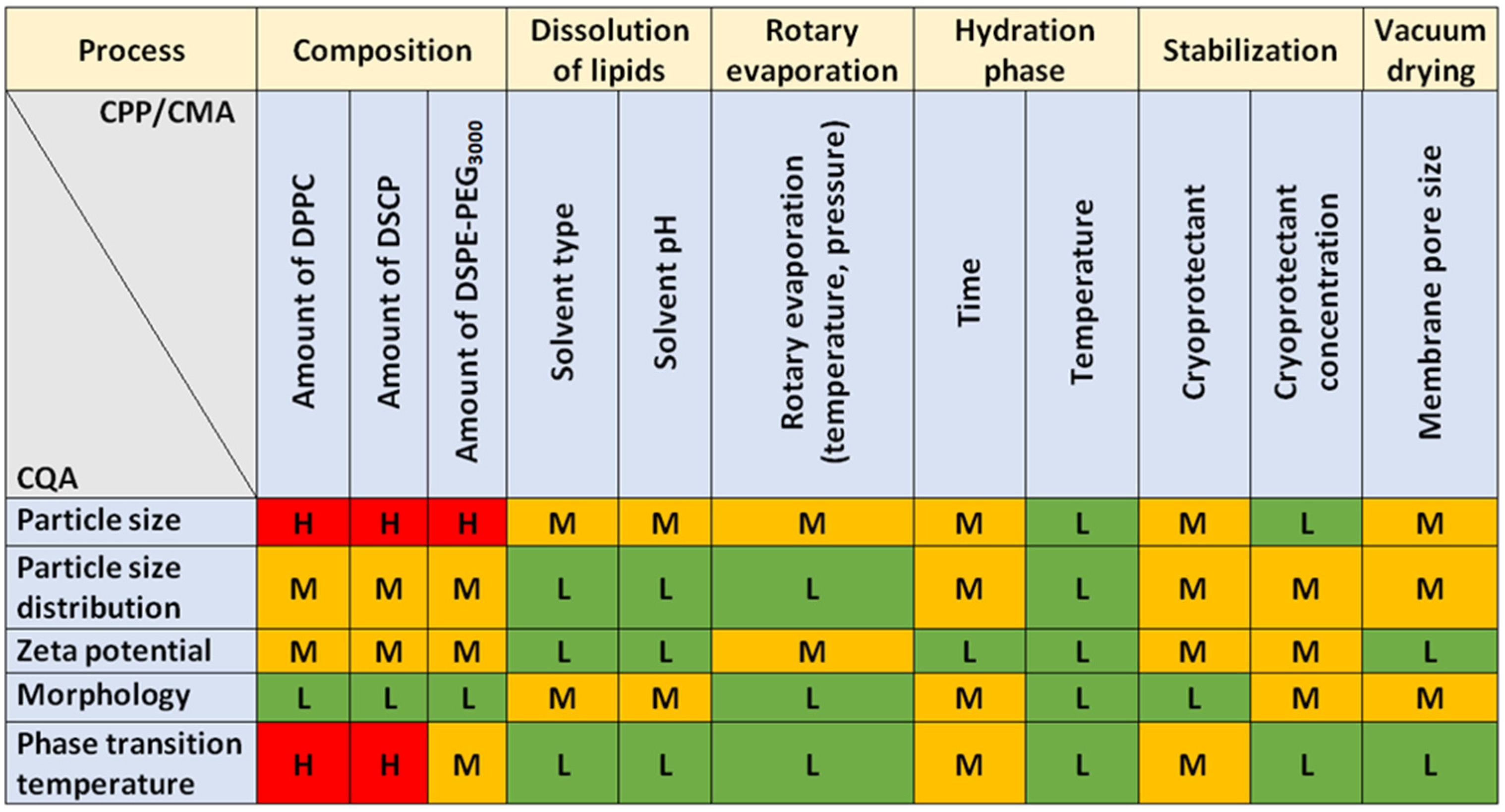


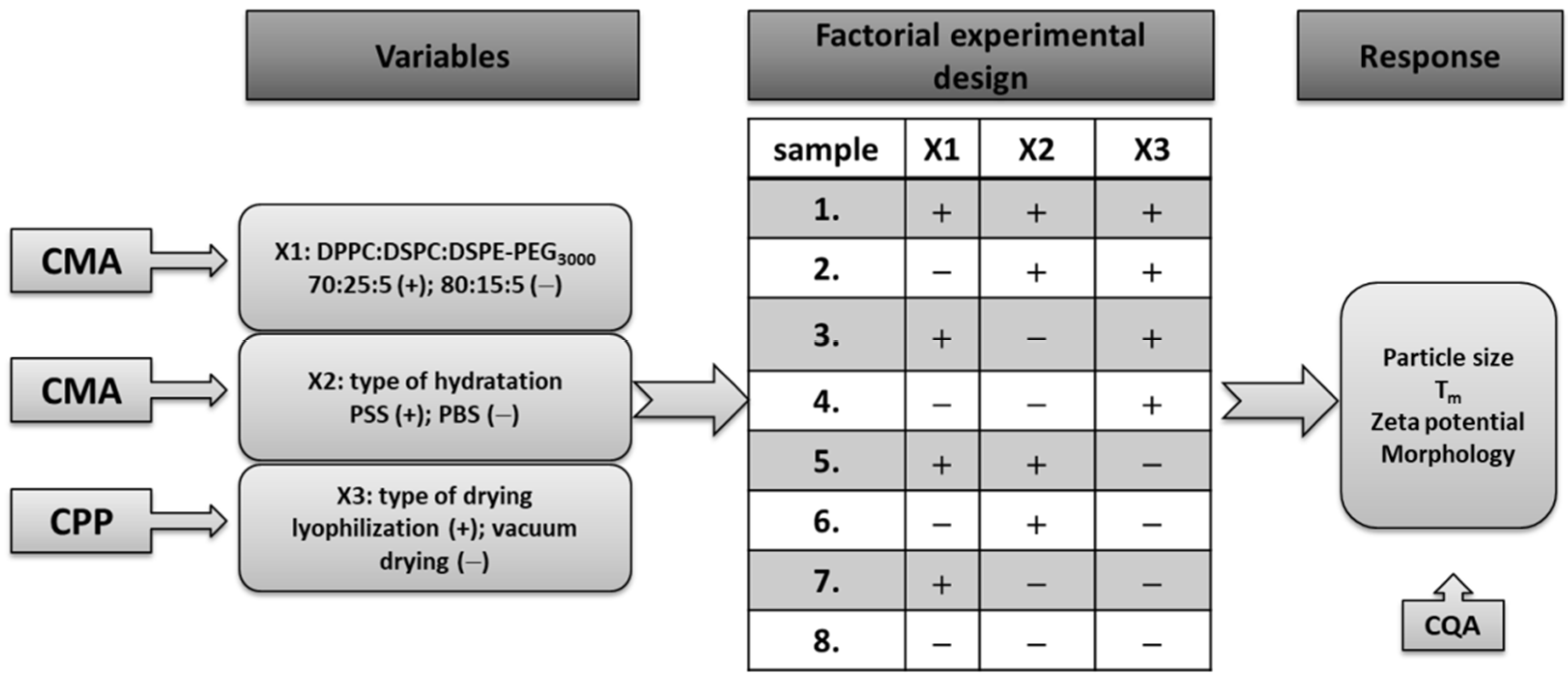
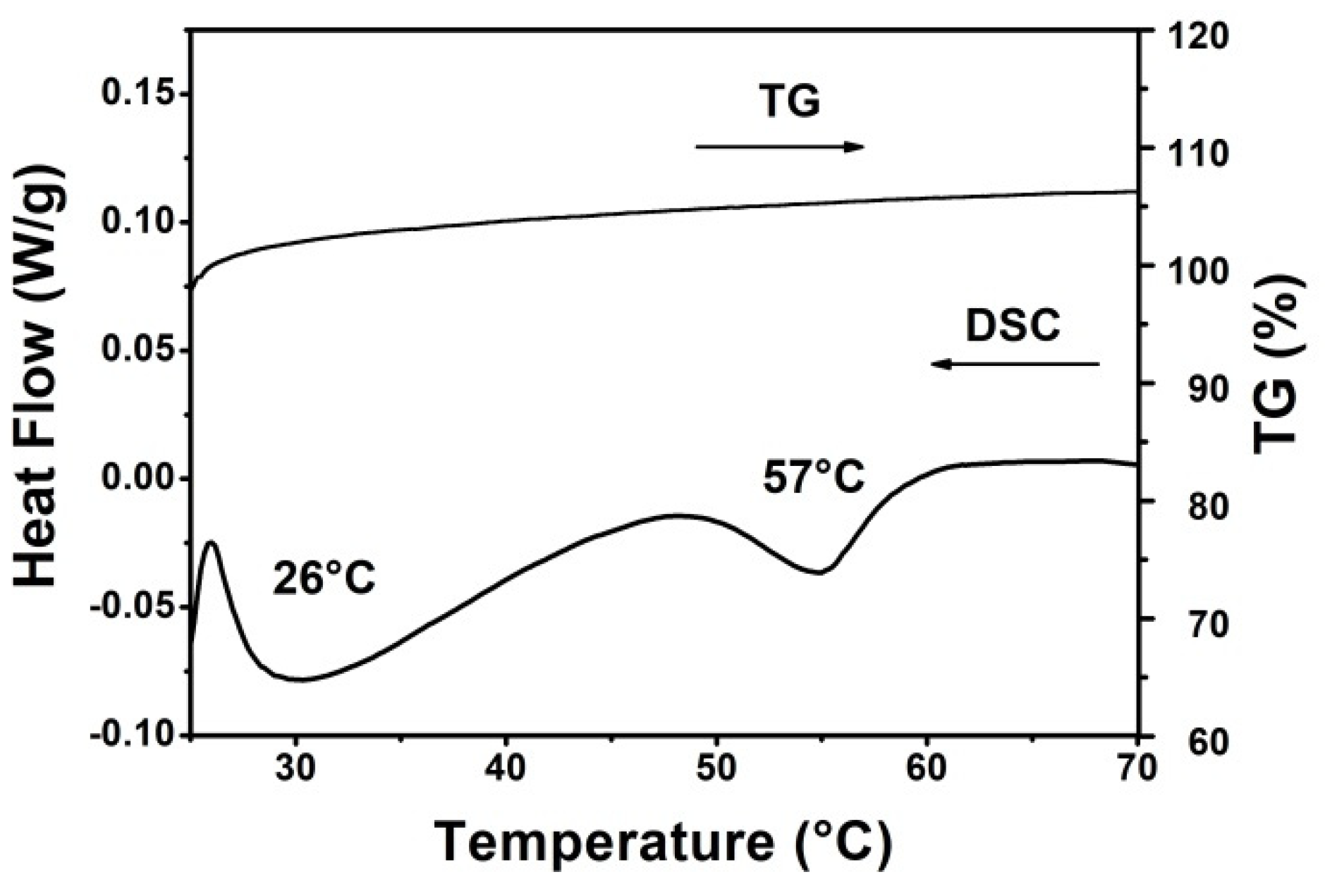
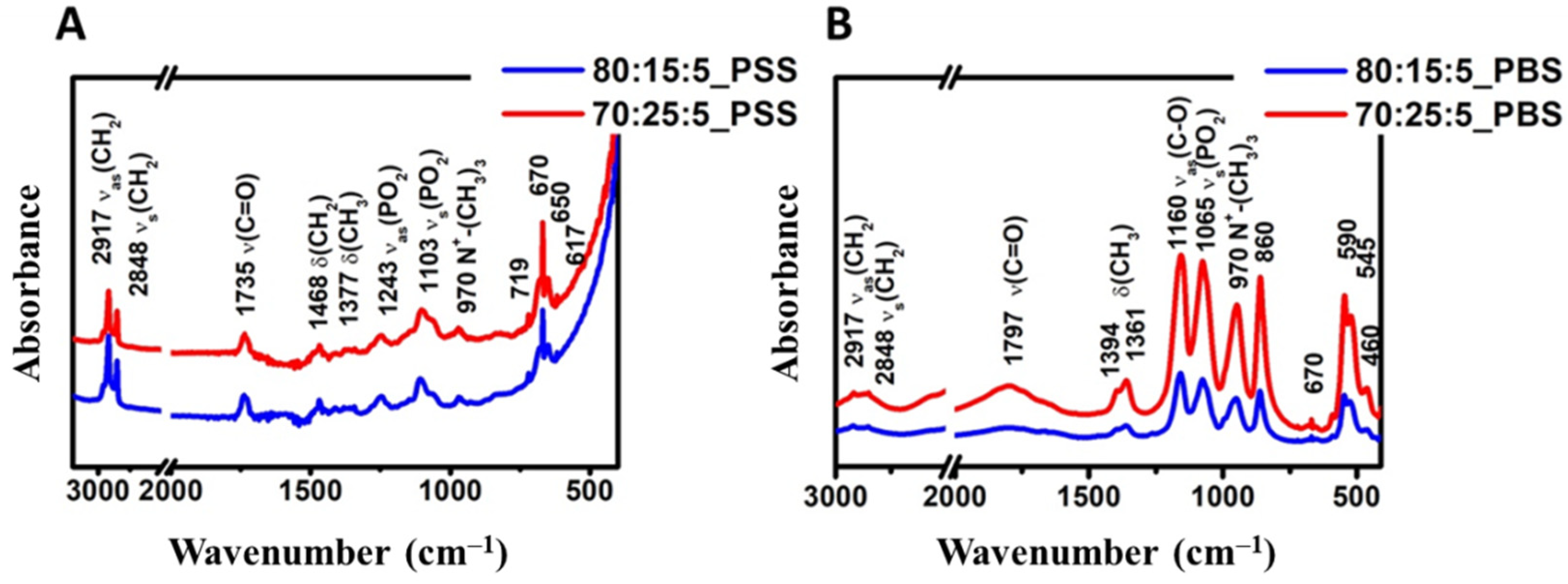
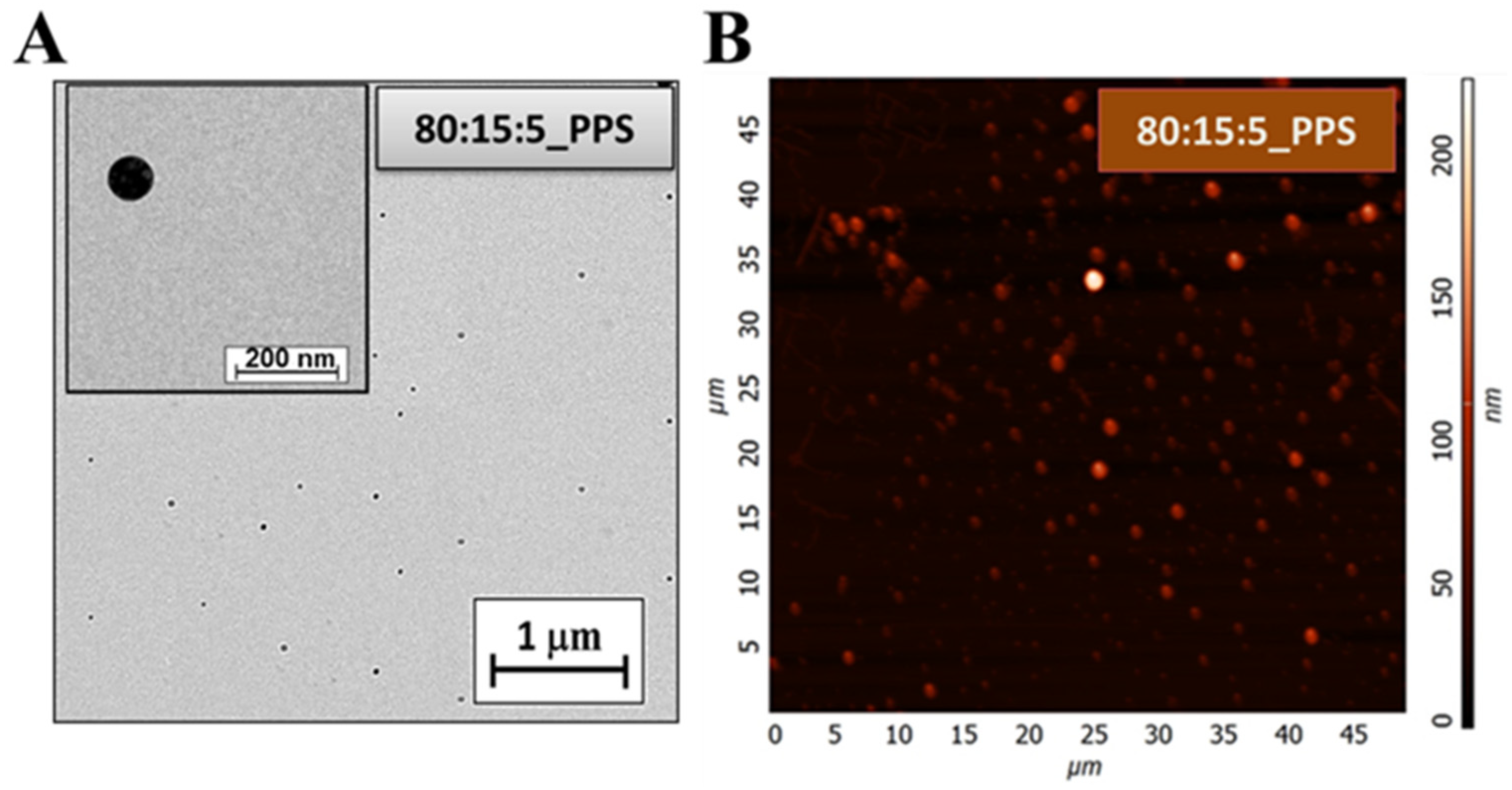
| Name of the Samples | Mole Ratio of Lipids | Hydration Media | ||
|---|---|---|---|---|
| DPPC | DSPC | DSPE-PEG3000 | ||
| 80:15:5_PSS | 80:15:5 | 0.9% NaCl solution (physiological saline) | ||
| 80:15:5_PBS | 80:15:5 | pH = 7.4 PBS (phosphate-buffered saline) | ||
| 70:25:5_PSS | 70:25:5 | 0.9% NaCl solution (physiological saline) | ||
| 70:25:5_PBS | 70:25:5 | pH = 7.4 PBS (phosphate-buffered saline) | ||
| QTPP Element | Target | Justification |
|---|---|---|
| Dosage form | Liposomal colloid solution | Liquid forms can be used in multiple dosage forms—such as nasal drops, eye drops, and nasal sprays—which improve patients’ adherence to therapy. |
| Size and distribution | 100 nm with monodisperse distribution | They can pass more efficiently across biological membranes in the appropriate nanosize range, resulting from improved dissolution and absorption profiles. |
| Physical stability | Stabilisable in solid form and retain the vesicle size after the dissolution | The thermodynamic stability of colloidal solutions can be achieved by the appropriate formulation, which results in stable particle size. |
| Response to temperature | Acquiring optimal physicochemical and particle characteristics that enable higher drug release tendencies | TLSs can be shaped to a suitable size and provide a favourable pharmacokinetic profile upon increasing temperature, which is beneficial for therapeutic use. |
| Type of nanocarrier | Nanosized thermosensitive liposomes | In addition to the properties of the vesicle-building materials, TLSs can increase bioavailability due to favourable physicochemical parameters. |
| Targetable administration route | Applicable for multiple administration routes, such as nasal, ocular, parental, etc. | Administration through alternative routes provides an opportunity to target biological compartments that conventional peroral dosage forms cannot, or if so, then poorly. |
| Sample Name | After Synthesis | Two Weeks Later | After Heat Treatment | ||||||
|---|---|---|---|---|---|---|---|---|---|
| Size (nm) | Zeta Potential (mV) | PDI | Size (nm) | Zeta Potential (mV) | PDI | Size (nm) | Zeta Potential (mV) | PDI | |
| 80:15:5_PSS | 75 ± 2 | −2.74 ± 0.67 | 0.25 ± 0.04 | 70 ± 0.5 | −4.00 ± 0.48 | 0.24 ± 0.004 | 90 ± 4 | −2.45 ± 0.55 | 0.35 ± 0.006 |
| 80:15:5_PBS | 130 ± 2 | −3.46 ± 1.02 | 0.40 ± 0.03 | 92 ± 0.5 | −5.82 ± 2.58 | 0.25 ± 0.004 | 161 ± 1 | −3.70 ± 0.23 | 0.39 ± 0.03 |
| 70:25:5_PSS | 154 ± 5 | −2.98 ± 0.93 | 0.34 ± 0.02 | 75 ± 1 | −4.53 ± 1.44 | 0.22 ± 0.006 | 78 ± 1 | −2.54 ± 1.21 | 0.22 ± 0.004 |
| 70:25:5_PBS | 165 ± 1 | −3.56 ± 0.59 | 0.34 ± 0.005 | 97 ± 1 | −6.00 ± 2.36 | 0.53 ± 0.04 | 71 ± 1 | −3.79 ± 1.19 | 0.360 ± 0.36 |
| T (°C) | Size (nm) | PDI | Zeta Potential (mV) |
|---|---|---|---|
| 10 | 64 ± 1.2 | 0.29 ± 0.04 | −2.23 ± 0.1 |
| 20 | 69 ± 3.2 | 0.24 ± 0.01 | −1.42 ± 0.16 |
| 30 | 80 ± 1.8 | 0.26 ± 0.01 | −1.92 ± 0.41 |
| 35 | 78 ± 1.1 | 0.26 ± 0.01 | −1.54 ± 0.43 |
| 37 | 80 ± 0.4 | 0.26 ± 0.01 | −1.98 ± 0.41 |
| 40 | 85 ± 2.8 | 0.27 ± 0.01 | −1.39 ± 0.5 |
Publisher’s Note: MDPI stays neutral with regard to jurisdictional claims in published maps and institutional affiliations. |
© 2022 by the authors. Licensee MDPI, Basel, Switzerland. This article is an open access article distributed under the terms and conditions of the Creative Commons Attribution (CC BY) license (https://creativecommons.org/licenses/by/4.0/).
Share and Cite
Dobó, D.G.; Németh, Z.; Sipos, B.; Cseh, M.; Pallagi, E.; Berkesi, D.; Kozma, G.; Kónya, Z.; Csóka, I. Pharmaceutical Development and Design of Thermosensitive Liposomes Based on the QbD Approach. Molecules 2022, 27, 1536. https://doi.org/10.3390/molecules27051536
Dobó DG, Németh Z, Sipos B, Cseh M, Pallagi E, Berkesi D, Kozma G, Kónya Z, Csóka I. Pharmaceutical Development and Design of Thermosensitive Liposomes Based on the QbD Approach. Molecules. 2022; 27(5):1536. https://doi.org/10.3390/molecules27051536
Chicago/Turabian StyleDobó, Dorina Gabriella, Zsófia Németh, Bence Sipos, Martin Cseh, Edina Pallagi, Dániel Berkesi, Gábor Kozma, Zoltán Kónya, and Ildikó Csóka. 2022. "Pharmaceutical Development and Design of Thermosensitive Liposomes Based on the QbD Approach" Molecules 27, no. 5: 1536. https://doi.org/10.3390/molecules27051536
APA StyleDobó, D. G., Németh, Z., Sipos, B., Cseh, M., Pallagi, E., Berkesi, D., Kozma, G., Kónya, Z., & Csóka, I. (2022). Pharmaceutical Development and Design of Thermosensitive Liposomes Based on the QbD Approach. Molecules, 27(5), 1536. https://doi.org/10.3390/molecules27051536










